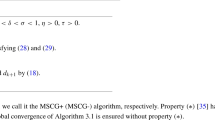Abstract
The solution of linear equationsCu 0+b=0 foru 0 is considered here, withC a positive-definite and self-adjoint operator. Such equations arise when solving quadratic optimization problems and (for example) when solving partial differential equations using finite-difference methods. A standard solution technique is to approximateC by an operatorK which is easy to invert and then to construct an algorithm of the contraction-mapping type to useK −1 iteratively to help solve the original equation. Such algorithms have long been used for solving equations of this type. The aim of the paper is to show that, for eachK, a little-known generalization of the usual conjugate-gradient algorithm has advantages over the corresponding contraction-mapping algorithm in that it has better convergence properties. In addition, it is not significantly more difficult to implement. IfK is a good approximation toC, the resulting generalized conjugate-gradient algorithm is more effective than the usual conjugate-gradient algorithm.
Similar content being viewed by others
References
Varga, R. S.,Matrix Iterative Analysis, Prentice-Hall, Englewood Cliffs, New Jersey, 1962.
Kolmogorov, A. N., andFomin, S. V.,Elements of the Theory of Functions and Functional Analysis, Graylock Press, New York, New York, 1961.
Riesz, F., andNagy, B. S.,Functional Analysis, Frederick Ungar, New York, New York, 1965.
Langlois, W. E.,Conditions for Termination of the Method of Steepest-Descent After a Finite Number of Iterations, IBM Journal of Research and Development, Vol. 10, No. 1, 1966.
Hestenes, M. R.,The Conjugate-Gradient Method for Solving Linear Systems, Proceedings of the Symposium on Applied Mathematics, Vol. 6, Numerical Analysis, pp. 83–102, 1956.
Daniel, J. W.,The Approximate Minimization of Functionals, Prentice-Hall, Englewood Cliffs, New Jersey, 1971.
Freeman, E. A.,On the Optimization of Linear, Time-Variant, Multivariable Controls Systems Using the Contraction Mapping Principle, Journal of Optimization Theory and Applications, Vol. 3, No. 6, 1969.
Allwright, J. C.,Generalized Conjugate-Gradient Algorithm for Optimal Control, Proceedings of the IEEE Conference on Decision and Control, New Orleans, Louisiana, 1972.
Allwright, J. C.,Improving the Conditioning of Optimal Control Problems using Simple Models, Proceedings of the IMA Conference on Recent Mathematical Developments in Control, Bath, England, 1972.
Author information
Authors and Affiliations
Additional information
Communicated by J. V. Breakwell
The computed results presented in Section 4 were obtained by P. Bluett while a research student at Imperial College.
Rights and permissions
About this article
Cite this article
Allwright, J.C. Conjugate gradient versus contraction mapping. J Optim Theory Appl 19, 587–611 (1976). https://doi.org/10.1007/BF00934657
Issue Date:
DOI: https://doi.org/10.1007/BF00934657




